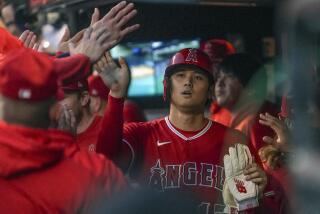Book review: ‘Real’ by Takehiko Inoue
- Share via
Unlike their counterparts in the squeaky-clean world of American comics, the teenagers in Takehiko Inoue’s award-winning manga series “Real” face graver problems than: Will Archie ask Betty or Veronica to the hop?
Intensely dedicated Kiyoharu Togawa was about to become the top junior high sprinter in Japan; then his right leg was partially amputated because of osteosarcoma. Hisanobu Takahashi, the arrogant captain of the Nishi High basketball team, stole a bicycle to impress a girl and rode into the path of a dump trunk. He woke up in the hospital a week later with no feeling below the waist. Hisanobu’s former teammate Tomomi Nomiya saw his life fall apart when a girl he’d just met was injured in a motorcycle accident. Overwhelmed by grief and guilt, he quit the team, then dropped out of school.
A love of basketball brings these troubled young men together. Kiyoharu can no longer run at his previous pace, so he’s transferred his competitive spirit to wheelchair basketball. He draws bad boy Tomomi into the game, and Hisanobu will almost certainly follow.
Kiyoharu refuses to be limited by the loss of his leg. He was temporarily kicked off the Tigers, a team started by an old friend, because he punched a player who told him not to expect much of his teammates because “we’re disabled.” One observer says of Kiyoharu, “He isn’t disabled … he’s a genuine athlete,” and he is. But he still thinks like a competitor in an individual sport, and he has to learn to be an effective team player.
Kiyoharu also has a vulnerable side. After drinking his first beer, Kiyoharu drops his warm-up pants and stands in front of his friends in a T-shirt and boxers to reveal his prosthesis. He tearfully confesses that his father used to cheer his track victories, but “with my leg like this … he won’t even look directly at me.”
After a chance meeting, Tomomi befriends Kiyoharu, whose courage he admires — and contrasts with his own unfocused life. When he gets in a fight to rescue a dog from some sadistic punks, Tomomi tells one of them, “You can hit me, but I won’t feel it. I’m already beat down as low as I can go.” But as he becomes the de facto coach of the Tigers, Tomomi begins to turn his life around. He may not have been an academic star, but he knows basketball — and enough applied psychology to get the best out of Kiyoharu and his teammates.
In the early books of the series, Hisanobu faces the daunting task of rebuilding his shattered world, as Kiyoharu and Tomomi learn to do. Hisanobu can no longer look down on people from the Olympian heights of athletic and academic excellence. He needs someone to bathe him and change his diapers. Although Inoue fills his narrative with unexpected turns, it’s clear Kiyoharu and Tomomi will teach Hisanobu a lot. But those lessons won’t be easy to learn or teach: Hisanobu expresses his rage and despair by antagonizing his physical therapist, tormenting his nurses and insulting his parents.
A skilled draftsman, Inoue tells much of his story visually. His clear line drawings capture Kiyoharu’s intensity as he sizes up a situation during a game. Tomomi loses his hangdog slouch and adopts a new body language the minute he grabs a basketball. When Tomomi hurts his hand in a fight, Inoue’s drawings of the swollen knuckles make the reader wince. Although wheelchair basketball differs from the conventional game, it’s an intense, demanding sport which is suggested by Inoue’s use of horizontal crosshatching.
Inoue seems to enjoy creating challenges for himself. When the Tigers lose a bet, they have to shave their heads. Kiyoharu and his teammates look naked and strange without their hair, but they’re still recognizable as the characters the reader knows. Keeping a character’s likeness after a radical change in appearance is an assignment only a master draftsman could pull off.
Inoue’s focus on disabled athletes gives “Real” a greater depth than standard sports sagas. Inoue neither hides nor over-dramatizes the pain his characters battle, proving that graphic novels can convey a broader range of human experiences than American audiences expect.
When “Real” won the Excellence Award for manga at the 2001 Japan Media Arts Festival, the judges said they could hardly wait to read the next installments and had to content themselves with awarding it the prize. Readers of this lively translation by John Werry will agree.
Solomon is the author, most recently, of “The Art of Toy Story 3.”
More to Read
The biggest entertainment stories
Get our big stories about Hollywood, film, television, music, arts, culture and more right in your inbox as soon as they publish.
You may occasionally receive promotional content from the Los Angeles Times.










